Overnight New York Style Bagels
These bagels are chewy, crusty and properly dense New York Style Bagels. The overnight rise creates the perfect texture and flavor – and you’ll have fresh, hot bagels for breakfast or brunch less than an hour after getting out of bed.
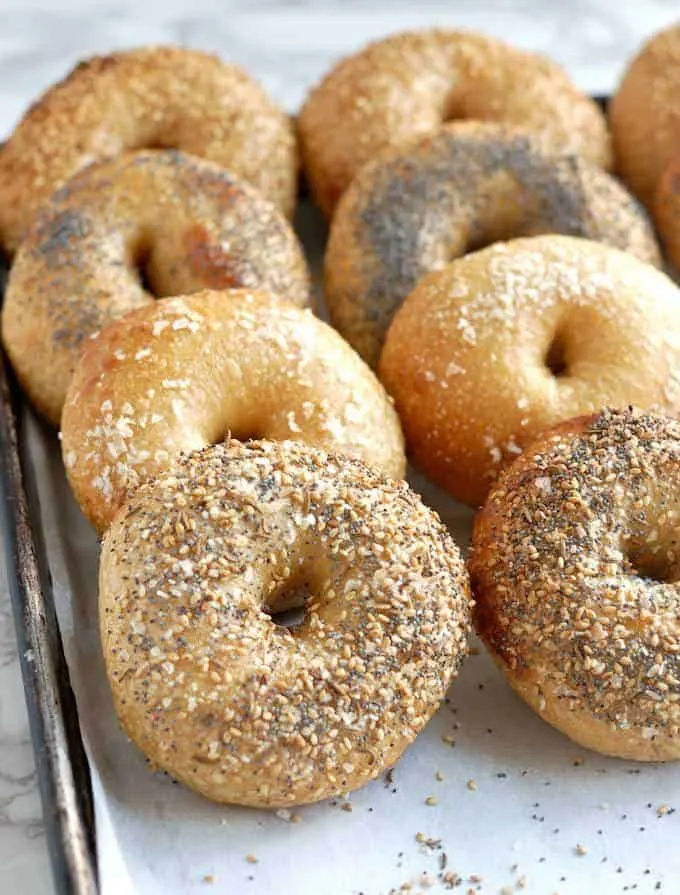
What is a true New York Style Bagel?
I promise you if you follow this recipe correctly you can make a good bagel at home. I mean, there are loads of really bad bagels in the world and life is just too short to eat a bad bagel.
Like a really great loaf of Rye Bread there’s nothing like a true New York style bagel.
A good New York Style Bagel (really, is there any other kind?) must have a nicely dense and chewy texture with a toothsome crust.
To get that characteristic chewiness we’ve got to develop some really strong gluten in the dough.
If you’ve got a sourdough starter, you can make Homemade Sourdough Bagels .
Ingredients
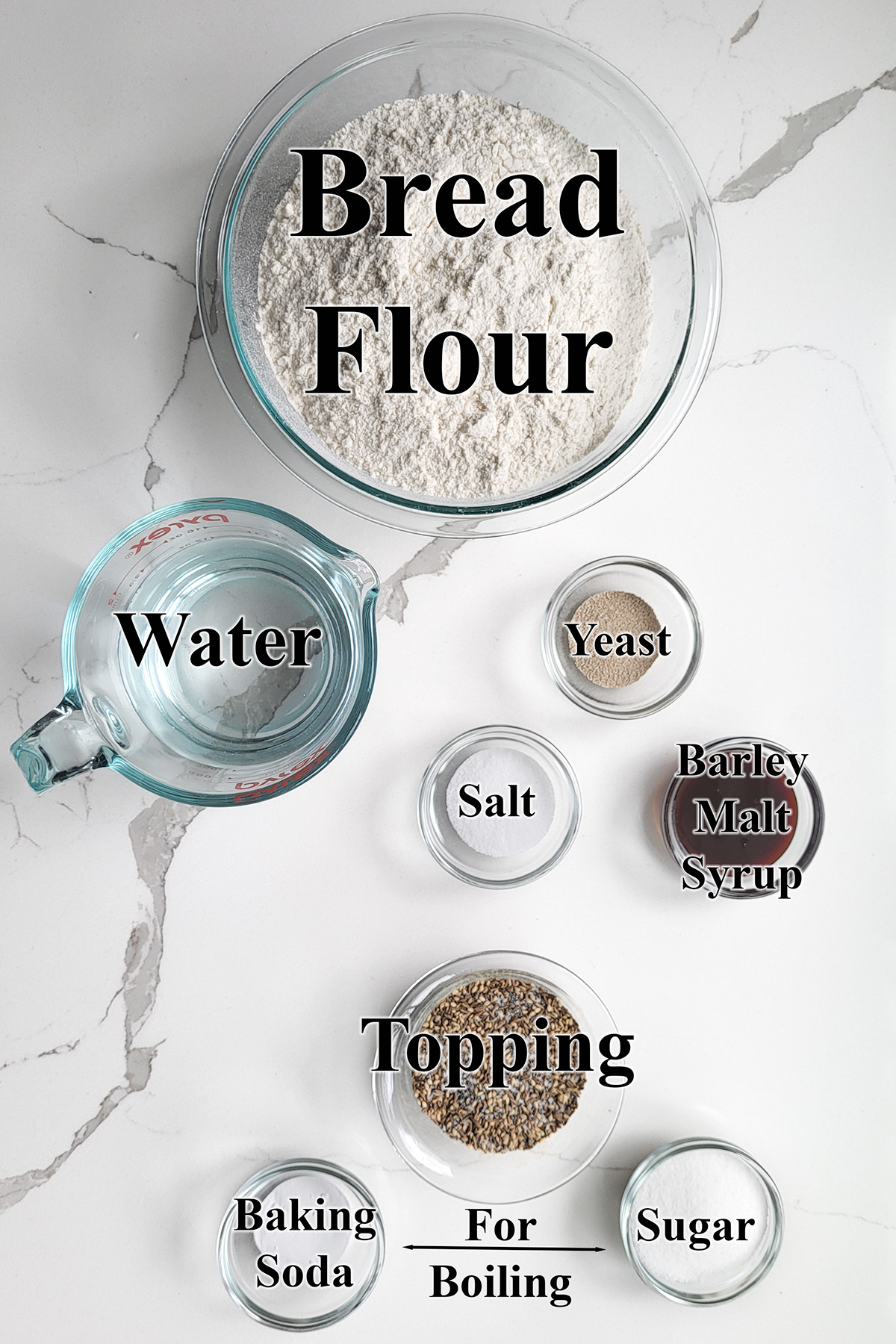
Ingredient Notes
- Bread Flour – Bagels should have a very chewy crumb from a strong gluten network in the dough. High protein bread flour develops plenty of gluten.
- Yeast – I prefer instant yeast to rapid rise yeast for a slightly slower rise. A slow overnight rise gives more time for flavor to develop.
- Barley Malt Syrup – Adds a traditional slightly sweet note to the dough. You can substitute honey or a combination or honey and molasses for the barley malt syrup.
- Toppings – Leave the bagels plain or use your favorite seed for topping. You can mix seeds with salt to make your own “everything” bagel topping”. See the recipe card for details.
- Baking Soda & Sugar – For boiling the bagels. The boiling process creates the specific shiny and chewy bagel crust.
How to make New York style Bagels
See the recipe card for detailed measurements and instructions.
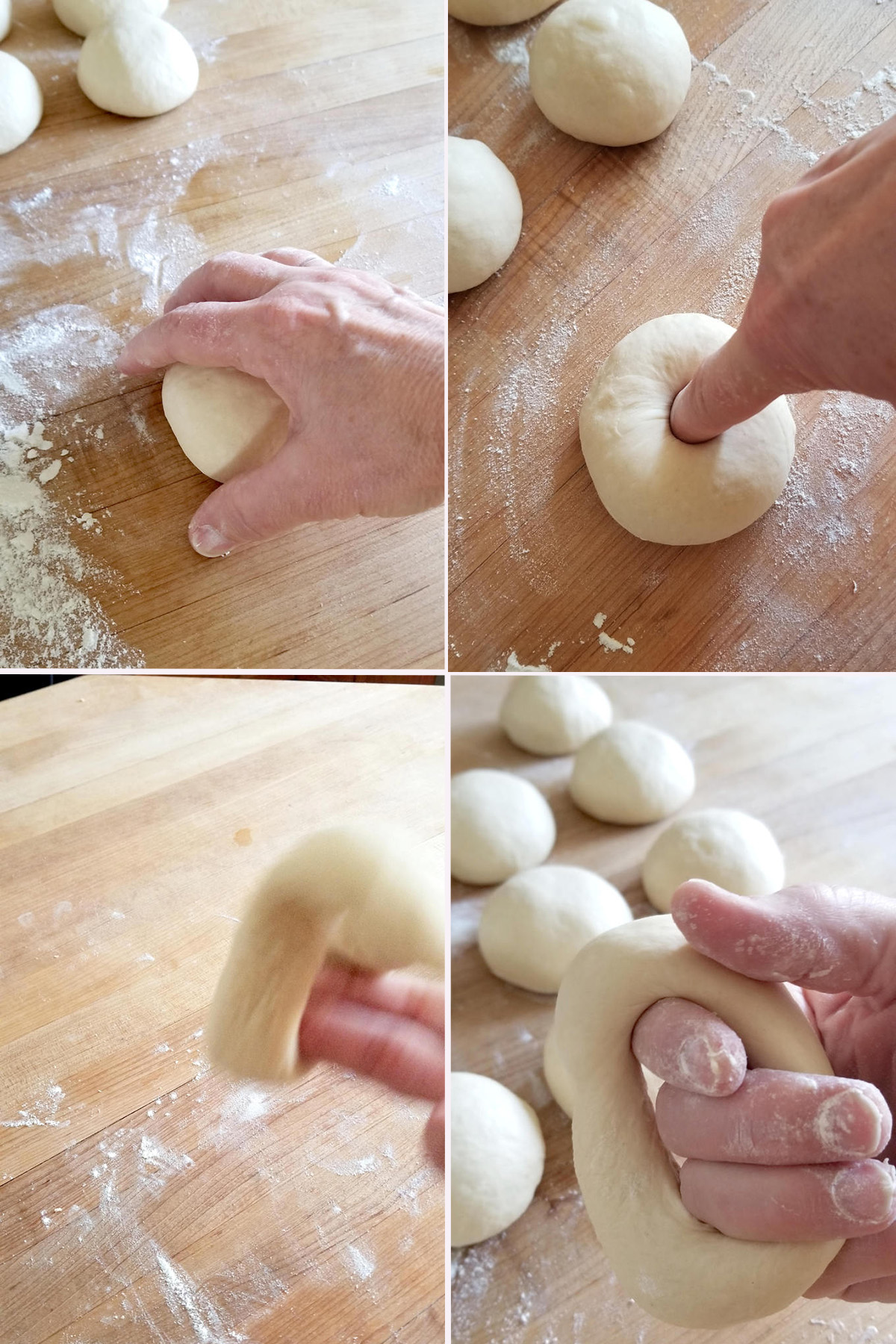
- Use a cupped hand to form the a piece of dough into a smooth ball.
- Poke your finger all the way through the center of the ball to make a hole.
- Twirl the dough around your fingers to widen the center hole.
- Set the bagel onto the baking sheet and continue with the rest of the dough.
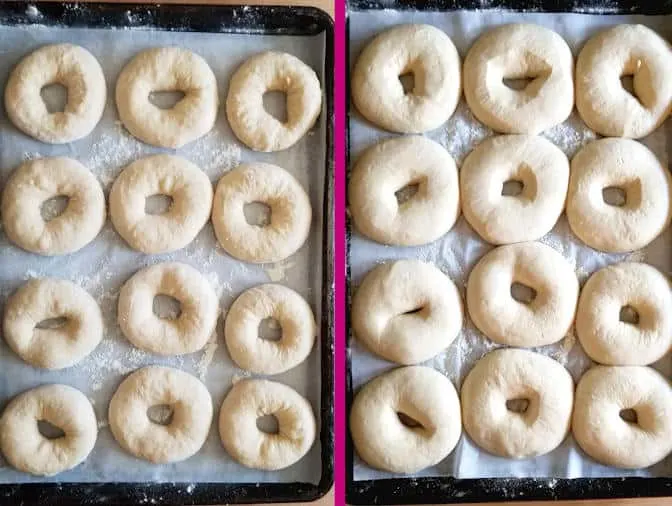
- Cover the pan and place the bagels in the refrigerator overnight.
- If you want to make the bagels the same day set them aside at room temperature for 1 hour.
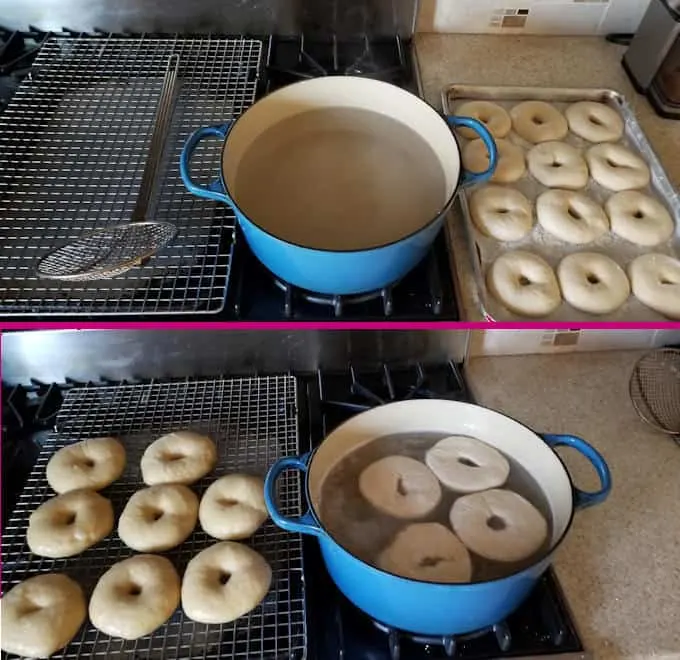
- Bring a pot of water with baking soda and sugar to a boil. Preheat the oven.
- Boil the bagels a few at a time, flipping them every thirty seconds. Boil each batch for 2 minutes.
- Transfer the bagels to a rack to drain while you finish boiling the rest of the bagels.
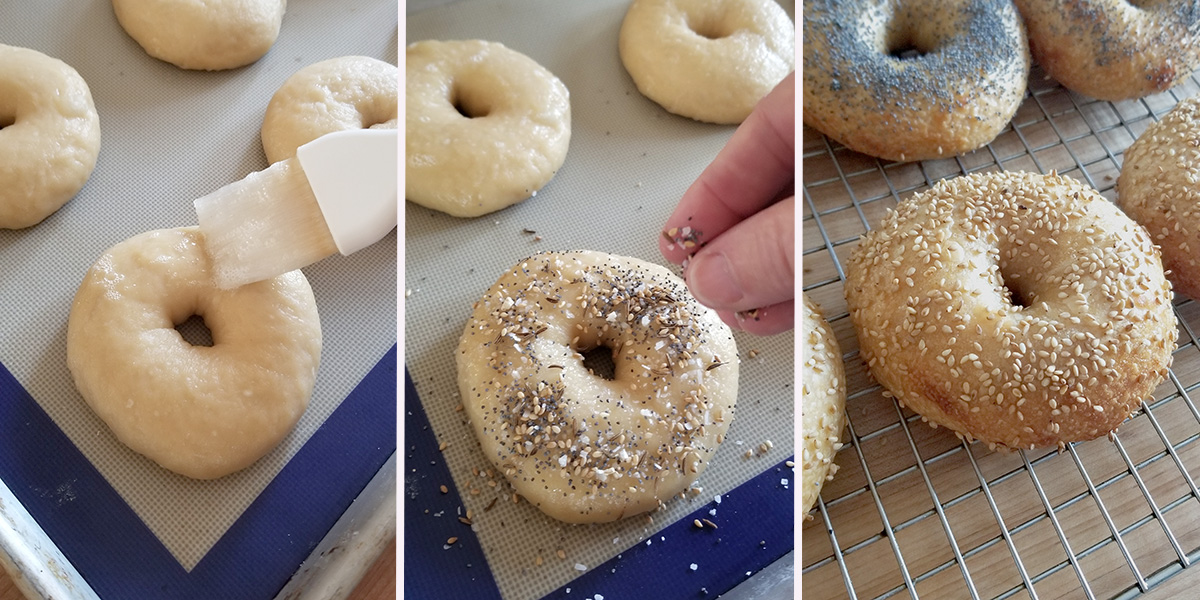
- Brush the boiled bagels with egg white.
- Sprinkle seeds or bagel topping if desired.
- Bake until the bagels are golden brown.
Recipe Tips
- Allow the sponge to rest for 30 minutes before mixing the dough. During that rest the water has time to hydrate the flour and gives us a head start on gluten develop.
- To make the bagels the same day, skip the overnight rise in the refrigerator.
- Bagels are best the day they are baked. For longer term storage slice the bagels about 3/4 the way through and pack them into freezer bags.
- Previously frozen bagels are best if toasted before serving.

You might also like to try these Cinnamon Raisin Bagels.
If you love this recipe as much as I do, I’d really appreciate a star rating and a quick comment. Ratings and comments help my recipes show in search results. Thanks!
Overnight Bagel Recipe
Ingredients
- 16 oz warm water (2 cups (about 100°F))
- ¼ oz instant yeast (2 ¼ teaspoons)
- 25 oz bread flour (5 cups, divided, see note)
- 1 ½ oz barley malt syrup ( 2 tablespoons, see note)
- 1 tablespoon table salt
- 2 oz granulated sugar (¼ cup (for boiling))
- 2 teaspoons baking soda (for boiling)
- 1 egg white (whisked lightly)
- Topping (Sesame seeds, poppy seeds, caraway seeds or coarse sea salt)
Instructions
- In a bowl for a stand mixer or a large mixing bowl combine 16 oz warm water, ¼ oz instant yeast and 3 cups (15 oz) of the flour . Mix to form a thick batter. Cover the bowl and set aside for 30-60 minutes.
- Add 1 ½ oz barley malt syrup and 1 tablespoon table salt. If using a stand mixer, switch to the dough hook. Add the remaining flour and mix to combine. Knead 5 minutes on medium/low speed. If working by hand, stir in as much of the flour as you can, then turn the dough out onto a lightly floured surface and knead in the remaining flour. Knead 5 minutes. Form the dough into a smooth ball.
- Put the dough into a lightly oiled bowl, turning once to coat the dough. Cover the bowl and set aside to rise until doubled in size, about 1 hour.
- Line a half sheet pan with parchment paper lightly sprinkled with flour or sprinkle the pan generously with cornmeal. Turn the dough out onto a lightly floured surface and knead briefly. Divide the dough into 10 even pieces. Use a cupped hand to roll each piece into a smooth, tight ball.
- To form a bagel, poke your finger all the way through the center of a ball to make a hole. Use two fingers to gently widen the hole. Continue gently stretching to form the bagel or twirl the dough around your fingers to widen the center hole (see photos). The hole should be 1 – 1 ½" wide.
- Place the bagel on the prepared sheet pan and continue to form the remaining bagels. The dough will probably spring back a bit so you can go back and re-stretch them once you're done forming all the bagels. Cover the pan with lighly oiled plastic wrap and leave at room temperature for 15 minutes then place the pan in the refrigerator overnight.
- In the morning, take the pan out of the refrigerator. The bagels should be noticeably fuller. Leave the tray out until the bagels come to room temperature, about 1 – 1 ½ hours. The time will vary based on the temperature in the room and how much the dough rose in the refrigerator. Once the dough comes to room temperature the bagels are ready to boil.
- Meanwhile, preheat the oven to 450 °F. In a large pot combine 1 gallon of water with 2 oz granulated sugar and 2 teaspoons baking soda and bring it to a boil. Reduce the heat to keep the water at a rolling simmer. Set a cooling rack over a clean sheet pan and place it next to the stove.
- Lift a bagel off the sheet pan and lower it into the boiling water, bottom side down. Depending on the size of your pot, you can boil 3-4 bagels at a time. Boil the bagels for 30 seconds then flip them. Boil the other side for 30 seconds. Repeat the process again for a total of 2 minutes boiling time. Remove the boiled bagels from the water and set them on the cooling rack to drain.
- Line two half-sheet pans with parchment paper or silicone baking mats and generously sprinkle with cornmeal (or flour). Place 5 of the boiled bagels on each sheet pan. You could fit them all on one pan but they may rise enough to stick together as they bake. I like all the sides to be crusty so I leave plenty of room between them.
- Brush the bagels with egg white. You can leave the bagels plain or add the topping of your choice. To make "everything" bagels combine a tablespoon of each of sesame seeds, poppy seeds & salt with a 1/8 teaspoon garlic powder and onion powder. Adjust toppings to your taste.
- Bake until golden brown, about 20 minutes.
Would you like to save this recipe?
As an Amazon Associate and member of other affiliate programs, I earn from qualifying purchases.









These turned out AMAZING! Thanks for the awesome recipe!
You are quite welcome! Glad you liked the recipe.
Best bagel recipe I have found yet and I have made a LOT of different recipes in the past 10 months. Thank you so much for sharing! I think I have found my new go-to recipe 🙂
Yay! So glad you like the recipe, Suzie. If you have a sourdough starter, I would definitely recommend that you try my Sourdough Bagel Recipe.
I’ve made this recipe twice and both times the bagels went flat as soon as they hit the water. Up to them going into the water, they were a great consistency, formed, had nice rise….put them in for their bath and they deflated…what can I do to prevent this?
They probably were over-risen. With the warmer weather the dough is going to rise more quickly. What I did the other day (with sourdough bagels) was take the bagels out of the fridge when the water was boiling and the oven was pre-heated. They went right into the water still cold from the fridge. They did sink, but they came back up to the surface pretty quickly. This worked really well with the sourdough bagels and would probably work for the yeasted bagels too. I’m going to update the post to include hints for warmer weather.
I loved them but found them quite salty. I am reading one tablespoon was it teaspoon of salt♀️
No, I use a tablespoon. There are 5 cups of flour is the recipe, which is quite a lot. You can use less salt if you prefer.
Can diastatic malt powder be substituted for malt syrup? I have seen it in some bagel recipes. If so, what would be the proper amount? Thanks
Hi Joanne, the barley malt syrup is in the recipe for the flavor. Diastatic malt powder includes enzymes that help condition the dough. The enzymes in the malt powder help the yeast grow to create a better rise and oven spring. I haven’t tried this recipe with malt powder, but according to the King Arthur Flour website you should use about 1/2 tsp per 3 cups of flour. If you use the malt powder, I would still use the malt syrup for flavor (or a mix of honey/molasses).
My bagels tasted delicious, but they were very flat. My only thought was that I possibly didn’t do the first step properly? i combined the water yeast and flour then mixed them to a thick consistancy. after 45 minutes I added the barley malt syrup and salt and mixed again. then i switched to the dough hook and added flour and kneaded 5 minutes. i then allowed to rise to double, kneaded slightly and formed my bagels.
any ideas? I followed the rest to the tea, but it seems my bagels never rose in the refrigerator at all. 🙁
Hi Winnie. It’s hard to say. Do you think the bagels were flat because they never rose or because they deflated? Did they spread out instead of rising up up? Did the dough have a good stretchy texture? After forming the bagels did you leave them at room temperature for 15 minutes before refrigerating? I made these bagels a couple of times and found that 15 minutes gave the bagels a little head-start on rising.
Mixing for so long might cause them to come out flat; mixing 5-10 minutes with the dough hook has always worked well for me
The recipe does specify kneading 5 minutes and that’s how long she said she kneaded. I find 5 minutes kneading on a stand mixer plenty of time, especially when using bread flour.
My bagels came out flat, too, but besides that super yummy. I noticed my dough was very wet and therefore also hard to handle, so next time I’m doing this recipe, I’m going to reduce water by 20% and hope this will help with the flattening, too.
Hi Hanna, a few suggestions for next time. Make sure you are using bread flour and not AP flour. The same amount of bread flour absorbs more water than AP flour. Make sure to let the sponge rest for 30 to 60 minutes before you finish mixing the dough. During this time the gluten will develop and the water will be absorbed. If you are not weighing your ingredients, use the “dip and sweep” method for measuring the flour. Dip the cup into the bin and sweep away the excess. If you spoon the flour into the measuring cup you’ll be using less flour than the recipe specifies since I always use the dip and sweep. Finally, make sure to flour the sheet pan for the bagels. If the dough sticks to the paper it can deflate a bit when you pick up the raw bagels. Please let me know if you have any other questions.
The problem is possibly using active dry yeast and not instant. My flat morning bagels led to further contemplation. I used active dry and had a spreading dough.
Active vs. instant would affect how fast the dough rises. Some folks add a little extra yeast when using active dry to get a quicker lift. The spreading dough would be more about the gluten development.
my second batch was flat. they did stick to the sheet pan! maybe this was my problem. i do feel i had the right ratio of water/flour and think they got kneaded plenty so must be what happened. they were delicious but super weirdly flat.
Mine come consistently flat with uncooked dough on the inside and a hard crust in the outside. tried lowering to 425 F and the same thing happened. Pretty bad recipe.
Many people have great success with this recipe, including me. I make then almost every week. I would be happy to trouble shoot with you if you have any specific questions.
my second batch was flat, but my first batch was amazing! i think they did stick to the sheet pan! maybe this was my problem. i do feel i had the right ratio of water/flour and think they got kneaded plenty so must be what happened. they were delicious but super weirdly flat. i will let you know how my third batch comes out, john
I have updated the recipe and post with more information which will hopefully prevent the sticking.
This recipe calls for sugar but never shows when to add it ….
Hi Renae, the sugar doesn’t go into the dough. The sugar and baking soda are added to the water for boiling the bagels.
I’ve used a water, non-diastatic malt powder bath to boil my bagels. I’m not sure the baking soda/sugar bath would give enough flavor. What do you think?